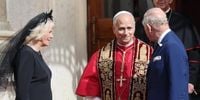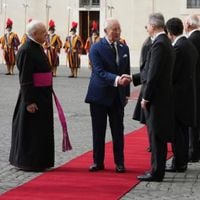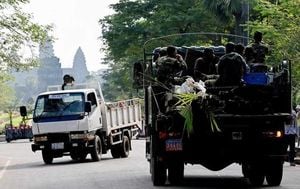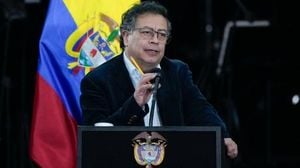On October 23, 2025, the eyes of the world turned to Vatican City as King Charles III and Queen Camilla arrived for a visit steeped in history and symbolism. The British royals’ presence in Rome, and their meeting with Pope Leo XIV, marked a watershed moment for relations between the Church of England and the Catholic Church—a relationship fractured nearly five centuries ago during the Reformation. For many, the event was more than a diplomatic courtesy; it was an unprecedented gesture of spiritual unity, even as the royal family faced turbulence back home.
The significance of the occasion was underscored by its setting. Charles and Camilla, seated in golden thrones on the raised altar of the Sistine Chapel—directly before Michelangelo’s awe-inspiring “Last Judgment”—joined Pope Leo XIV and the Anglican archbishop of York in an ecumenical service. As reported by Associated Press, this was the first time since the 16th century that the heads of the two churches had prayed together. The moment, centuries in the making, was not lost on those present or on the millions watching from afar.
The service itself was a harmonious blend of tradition and hope. Hymns echoed through the chapel, performed by members of the Sistine Chapel choir alongside the St. George’s Chapel choir of Windsor Castle and the children’s choir of the Chapel Royal of St. James’s Palace. The music, a shared heritage, seemed to underscore the possibility of unity between two Christian traditions long divided by doctrine and history.
According to Town & Country, the visit had been originally slated for earlier in the year but was postponed after the illness and subsequent death of Pope Francis. Charles, who had expressed a strong desire to visit the Vatican during the 2025 Holy Year—a once-every-quarter-century celebration of Christianity—was undeterred, and the event was rescheduled for October. The Holy Year, with its emphasis on forgiveness, pilgrimage, and renewal, provided a fitting backdrop for the royal-papal encounter.
But this spiritual milestone came as a welcome respite for the royal family, who were grappling with renewed scrutiny at home. The publication of a memoir by Virginia Giuffre, an accuser of convicted sex offender Jeffrey Epstein, once again thrust Prince Andrew, the king’s brother, into the spotlight. As AP detailed, the 65-year-old prince announced he would stop using his titles, including Duke of York, while “vigorously” denying Giuffre’s claims. Public pressure mounted on Buckingham Palace and the UK government to formally strip Andrew of his dukedom and princely status, and to evict him from his 30-room mansion near Windsor Castle. The timing of the Vatican visit, then, offered the king and queen a much-needed moment of spiritual solace amid domestic upheaval.
The day’s events carried layers of meaning, both ceremonial and personal. After the Sistine Chapel service, Charles was formally recognized at the pontifical basilica of St. Paul’s Outside the Walls—a church with deep historical ties to the English crown. There, he received the title “Royal Confrater,” a sign of spiritual fellowship not bestowed on a British monarch since Henry VIII’s dramatic break with Rome in 1534. In a reciprocal gesture, Pope Leo XIV was named “Papal Confrater of St George’s Chapel, Windsor Castle.”
As officials explained to AP, Charles was also presented with a special chair at the basilica, decorated with his coat of arms and bearing the Latin exhortation “Ut Unum Sint” (“That they may be one”). The chair is to remain at the basilica for Charles and his heirs—a tangible symbol of the hoped-for unity between the churches. The moment was not only historic but deeply personal for Charles, who has long balanced his constitutional role as supreme governor of the Church of England with his advocacy for religious pluralism and interfaith dialogue.
Cardinal Vincent Nichols, the Catholic archbishop of Westminster, told AP, “Pope Leo and King Charles coming together before God in prayer is an example of a genuine and profound co-operation.” He noted the significance of Charles’s dual role, “protecting freedom of religion and the important role of faith in society across his kingdom.”
The royal visit also included meetings beyond the ceremonial. According to Town & Country, King Charles met with Cardinal Pietro Parolin, the Holy See’s Cardinal Secretary of State, while Queen Camilla received a private tour of the Pauline Chapel, the most intimate chapel in the Apostolic Palace. These moments, though quieter, reinforced the warmth and depth of the royal-papal relationship.
Yet, even as the Vatican visit symbolized new hope for Christian unity, divisions within the Anglican Communion itself were coming to a head. Just weeks before the royal trip, the Church of England elected Sarah Mullally as the first female archbishop of Canterbury—a historic milestone that nonetheless exposed deep rifts. As AP reported, an organization of conservative Anglican primates, the Global Fellowship of Confessing Anglicans (Gafcon), announced it was rejecting the traditional bureaucratic links of the communion, citing both the Church’s LGBTQ-affirming stances and Mullally’s appointment. In their view, only men could be bishops, and they saw the move as a defining point of Anglican unity. The group, representing a majority of the communion’s membership, primarily in Africa, declared its intention to form a new structure, while still claiming to embody the historic Anglican tradition.
The archbishop of York, the Most Rev. Stephen Cottrell, stood in for Mullally at the Vatican service, as she had not yet been formally installed as spiritual leader. The absence was notable, a reminder that the path to unity—whether between Rome and Canterbury or within the Anglican world itself—is rarely straightforward.
Despite these challenges, the events in Rome signaled a willingness to move beyond old grievances. The Church of England’s split from Catholicism in 1534, sparked by King Henry VIII’s quest for an annulment, led to centuries of theological and political rivalry. While popes and monarchs have since made gestures of reconciliation, the issues dividing the churches—such as the ordination of women and the treatment of LGBTQ+ faithful—remain unresolved. Still, the sight of Charles and Camilla joining Pope Leo XIV in prayer, surrounded by the art and music of centuries, suggested that dialogue and fellowship are not only possible but necessary in an increasingly divided world.
As the royal couple departed the Vatican, the historic weight of the visit lingered. For the faithful and the curious alike, the events of October 23, 2025, offered both a glimpse of what unity might look like and a reminder of the work still to be done. For Charles and Camilla, the day was both a culmination of tradition and a hopeful step forward—a moment when history, faith, and the human need for connection converged beneath the frescoed ceiling of the Sistine Chapel.





